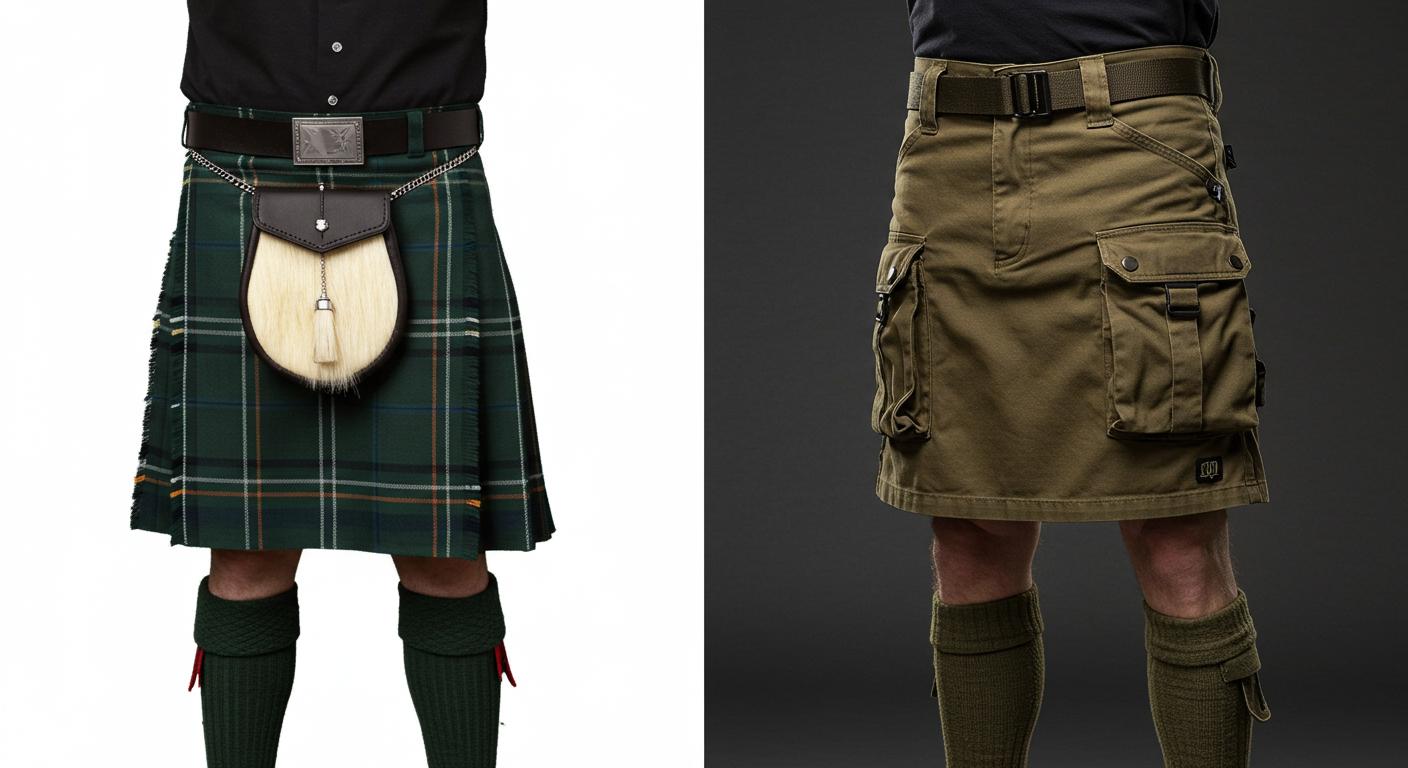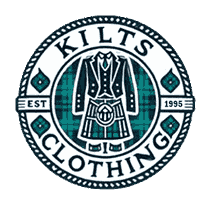Scottish Kilts vs. Utility Kilts: What’s the Difference and Which One is Right for You?

Kilts have long been iconic garments representing the cultural heritage of Scotland. The Scottish kilt has historically become synonymous with tradition, pride, and clan identity. However, there has been a growing trend toward utility kilts, which offer a more practical, versatile design in recent years. But how do these two types of kilts differ, and which one should you choose? This blog will explore the key differences between Scottish and utility kilts, helping you determine which suits your needs, style, and occasion.
What is a Scottish Kilt?
The Scottish kilt is a traditional garment that has been a symbol of Scottish culture for centuries. Made from woolen cloth, it typically features a plaid or tartan pattern. The design consists of pleats at the back, a flat front, and a waistband at the wearer's natural waist. Historically, the kilt was worn by Highland Scots as a practical piece of daily life. Still, it became a ceremonial garment worn for formal occasions over time.
Key Features of Scottish Kilts:
- Tartan Patterns: Scottish kilts are often associated with specific clans, with each tartan pattern representing a different Scottish family. Wearing a kilt in your clan's tartan is a significant cultural tradition.
- Material: Typically made of wool, Scottish kilts are designed for warmth and durability. The wool fabric also contributes to the formal appearance of the garment.
- Accessories: The Scottish kilt is often paired with accessories such as a sporran (a pouch worn at the front), Ghillie brogues (traditional shoes), kilt pins, and kilt hose (socks).
When to Wear a Scottish Kilt:
Scottish kilts are often worn for formal events, such as weddings, Highland Games, Burns Night celebrations, and other ceremonial occasions. They represent not only fashion but also a strong cultural connection to Scottish heritage.
What is a Utility Kilt?
In contrast to the traditional Scottish kilt, the utility kilt is a modern, functional version of the classic garment. While maintaining the kilt's characteristic knee-length cut and pleated design, utility kilts are made with more practical, durable materials such as cotton or polyester. They are designed to be more versatile and comfortable, catering to those who require both style and function.
Key Features of Utility Kilts:
- Practicality: Utility kilts often include cargo pockets, belt loops, and adjustable waistbands. These design elements make them more suited for activewear, especially for work or outdoor activities.
- Fabric: Unlike the wool used in Scottish kilts, utility kilts are often made from cotton or synthetic blends, which are easier to clean and more breathable, making them suitable for everyday wear.
- Durability: The rugged materials used in utility kilts are designed to withstand wear and tear, making them more practical for manual work or outdoor adventures.
When to Wear a Utility Kilt:
Utility kilts are more casual and are typically worn for everyday use, such as hiking, camping, or attending a festival. They have also gained popularity among those who appreciate alternative fashion styles, offering a unique blend of comfort and practicality.
Key Differences Between Scottish Kilts and Utility Kilts
While both kilts have their merits, the key differences are their material, design, functionality, and wear occasion.
1. Fabric & Material
- Scottish Kilts: Scottish kilts for sale are traditionally made from wool, a fabric that provides warmth and durability but requires careful maintenance. Wool is typically heavier, making Scottish kilts ideal for formal settings but less comfortable for day-to-day wear in warmer climates.
- Utility Kilts: Made from more lightweight materials like cotton, polyester, or denim, utility kilts are breathable, easy to maintain, and more suited for casual wear. They are machine washable, unlike Scottish kilts' more delicate woolen fabric.
2. Design & Functionality
- Scottish Kilts: The design of a traditional kilt scottish is both functional and formal, with pleats at the back, no pockets, and a clean, flat front. The waistband sits at the natural waist, and the kilt is often tailored to fit precisely.
- Utility Kilts: Utility kilts are designed for practicality. They feature cargo pockets, belt loops, and adjustable waistbands, making them perfect for people who need functionality in their attire. Whether carrying tools or needing extra storage for everyday items, utility kilts are built for convenience.
3. Style & Occasion
- Scottish Kilts: These kilts are generally reserved for formal or semi-formal occasions such as weddings, ceremonial events, and Highland Games. The tartan pattern, along with the accessories, gives the kilt a formal and elegant appearance.
- Utility Kilts: Utility kilts are far more casual and are often worn in less formal settings. They're ideal for outdoor festivals, casual gatherings, or even as workwear in specific trades. The design is more practical and less ceremonial.
Which Kilt is Right for You?
Choosing between a Scottish kilt and a utility kilt ultimately depends on your needs and the occasion.
Choosing Based on Occasion
- Scottish Kilts: A Scottish kilt is the obvious choice if you're attending a formal event like a wedding or cultural ceremony. The traditional tartan and matching accessories create a sophisticated, timeless look deeply connected to Scottish heritage.
- Utility Kilts: For a more casual look or when engaging in outdoor activities such as hiking, biking, or attending a music festival, utility kilts are more appropriate. Their practical design provides comfort, mobility, and functionality without sacrificing style.
Comfort & Fit
- Scottish Kilts: Scottish kilts are usually tailored for a precise fit, which can provide a more structured and polished appearance. However, this may limit comfort during casual or active use, as the garment is made with formal occasions in mind.
- Utility Kilts: These kilts offer a looser fit, making them ideal for comfort during everyday wear or outdoor activities. The addition of adjustable waistbands and the absence of a restrictive fit make utility kilts an excellent choice for active individuals.
Durability & Practicality
- Scottish Kilts: While durable, traditional wool kilts require more maintenance, such as dry cleaning and careful storage, to preserve the fabric. They are less suited for daily wear due to their formal nature.
- Utility Kilts: Designed for rugged use, utility kilts are more practical in everyday settings. Made from tough, machine-washable fabrics, they are built to withstand wear and tear and can handle various activities.
Pros and Cons of Scottish Kilts vs. Utility Kilts
Pros of Scottish Kilts
- Cultural Heritage: A Scottish kilt carries deep cultural and historical significance, making it a cherished garment for formal occasions.
- Timeless Style: Scottish kilts' classic design and tartan patterns offer a sophisticated, elegant look.
- Formal Appeal: Ideal for events like weddings, ceremonies, and Highland Games, where traditional attire is required.
Cons of Scottish Kilts
- Cost: High-quality wool kilts can be expensive, especially custom-made ones.
- Maintenance: Requires more care and upkeep, such as dry cleaning, to maintain the fabric's quality.
- Limited Use: Not suitable for casual wear or outdoor activities.
Pros of Utility Kilts
- Practicality: Featuring pockets, belt loops, and adjustable waistbands, utility kilts are designed for comfort and function.
- Versatility: Perfect for casual outings, workwear, or outdoor events like festivals.
- Durability: Made from strong fabrics that are easy to clean and designed to last.
Cons of Utility Kilts
- Less Formal: Not suitable for formal or traditional events that require the elegance of a Scottish kilt.
- Limited Cultural Significance: While practical, utility kilts lack Scottish kilts' historical and cultural importance.
Conclusion
Both Scottish and utility kilts offer unique benefits and can serve different purposes. The Scottish kilt is ideal for those seeking a formal, culturally rich garment for special occasions. In contrast, the utility kilt is perfect for those who need a more casual, functional option for everyday wear or outdoor activities. The choice between the two ultimately depends on your needs, style preferences, and the event you're attending.
Whatever kilt you choose, both styles are a testament to the enduring legacy of kilt-wearing culture, offering style and comfort in their ways.


